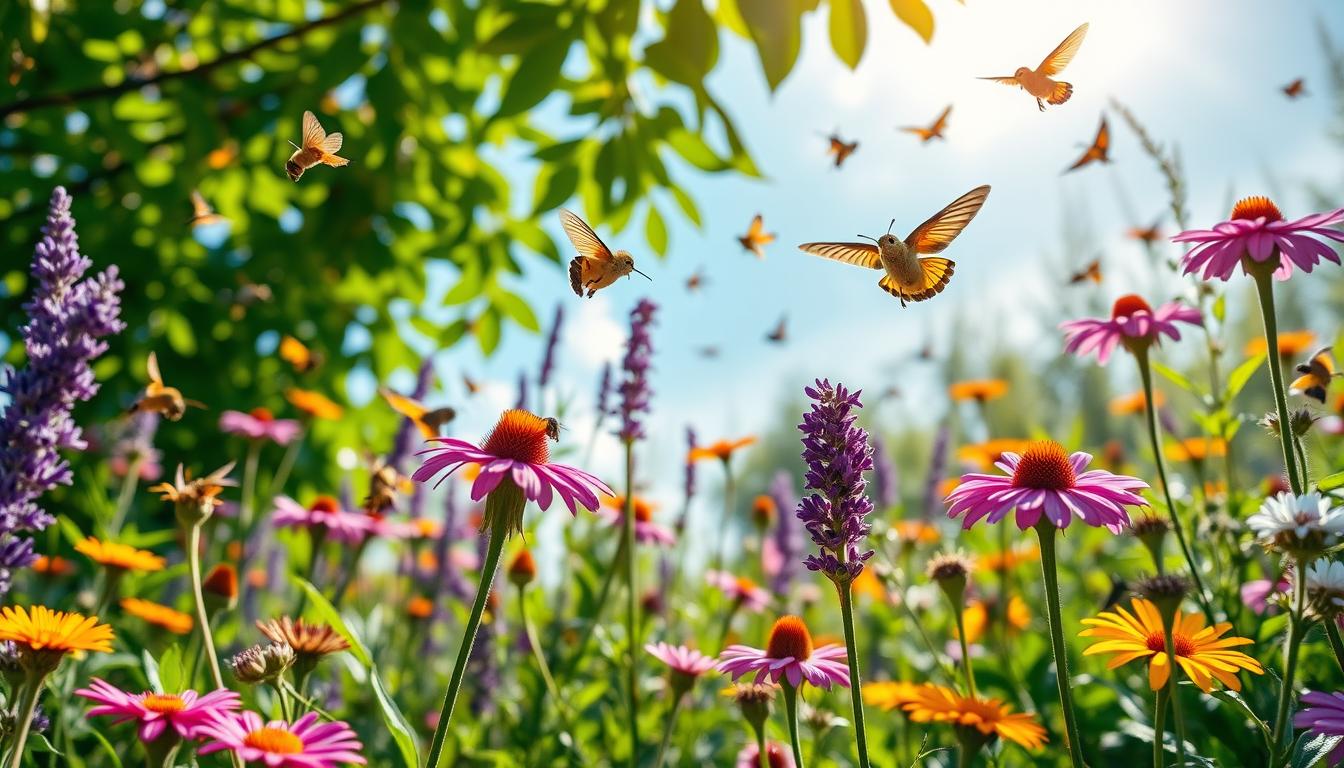I’m excited to share my knowledge on creating a thriving garden that attracts bees and butterflies. By choosing pollinator-friendly plants, we can make a positive impact on the environment. This helps in the conservation of these essential pollinators.
Attracting bees and butterflies to our gardens is crucial. It can be achieved by selecting the right plants. I’ll guide you through my top picks for a pollinator-friendly garden. This includes the best plants for bees and butterflies, to create a haven for these incredible creatures.
By incorporating pollinator-friendly plants into our gardens, we can provide a source of food and shelter for bees and butterflies. This supports their populations. I’ll share my expertise on attracting bees and butterflies. I’ll also provide tips on creating a beautiful and thriving garden that benefits both us and the environment.
Understanding the Importance of Pollinators
Exploring the world of pollinators shows us their vital role in our ecosystem’s health. By planting a bee and butterfly garden, we help create a home for them. This not only supports local pollinators but also beautifies our outdoor spaces.
Why Bees and Butterflies Matter
Bees and butterflies are key pollinators, crucial for many crops. Without them, our food supply would suffer greatly. By supporting these species, we ensure the ecosystem’s long-term health.
The Role of Pollen and Nectar
Pollen and nectar are vital for pollinators. Flowers for bees and butterflies offer these essential resources. By planting a variety of flowers, we create a rich habitat for them.
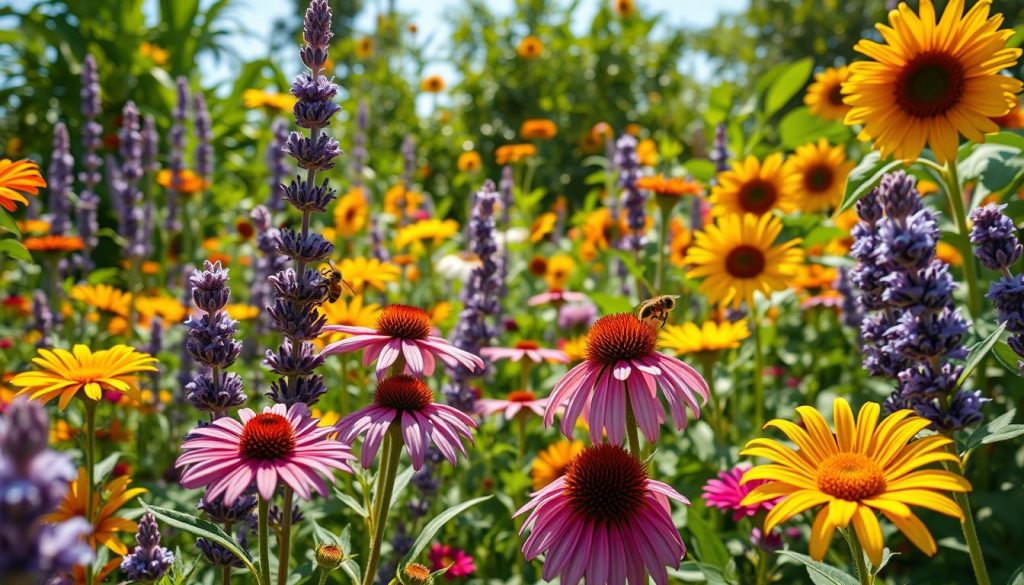
Threats to Pollinator Populations
Pollinators face many threats, like habitat loss and pesticide use. Understanding these threats helps us take action. Creating a bee and butterfly garden is a key step in protecting them.
My Favorite Flowering Plants for Bees
Creating a bee-friendly garden starts with the right plants. I’ve learned that plants full of nectar and pollen are key. They attract bees and butterflies, offering food and shelter.
Echinacea (Coneflower)
Echinacea, or coneflower, is a favorite for gardens. It’s a perennial with lots of nectar and pollen. This makes it a great choice for bees and butterflies.
Lantana
Lantana is another top pick for me. It’s a shrub that’s easy to care for. Its small flowers are full of nectar and pollen, attracting bees and butterflies.
Black-Eyed Susans
Black-Eyed Susans are a classic choice for gardens. They’re easy to grow and have bright yellow flowers. These flowers are full of nectar and pollen, perfect for bees and butterflies.
Other great plants for bees and butterflies include:
- Zinnias
- Cosmos
- Marigolds
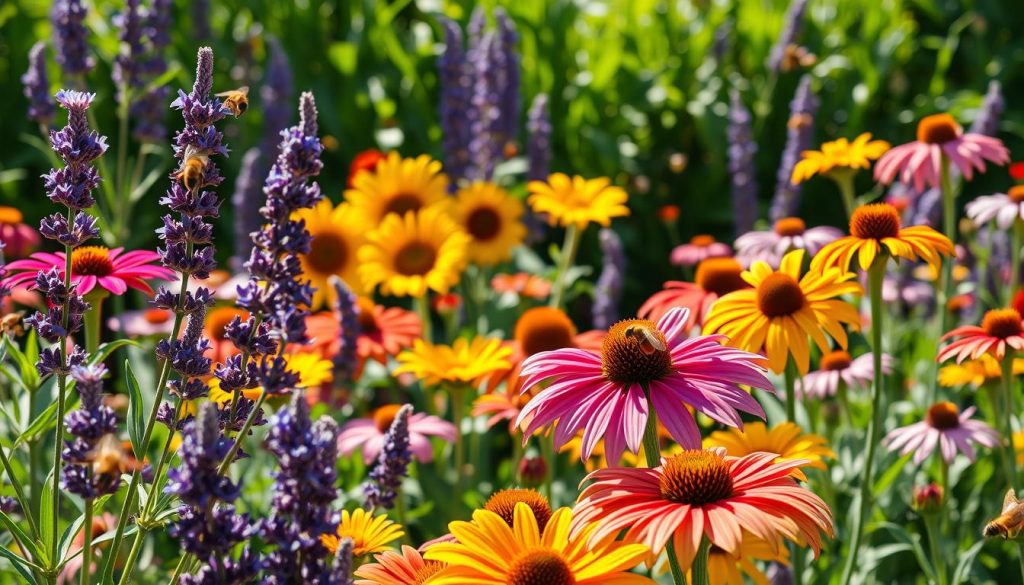
Stunning Choices for Butterflies
Butterflies add beauty to any garden. Choosing the right plants is key to attracting them. A variety of flowers for bees and butterflies is essential. This creates a haven for these creatures and lets you enjoy their grace.
To attract butterflies, consider these plants:
- Milkweed: a vital food source for monarch butterfly caterpillars
- Joe Pye Weed: a tall, stately plant that provides nectar for adult butterflies
- Sedum: a low-maintenance plant that offers a rich source of nectar for butterflies
These plants attract both butterflies and bees. They’re perfect for a garden that supports many pollinators. Adding these flowers to your garden lets you enjoy their beauty and supports their well-being.
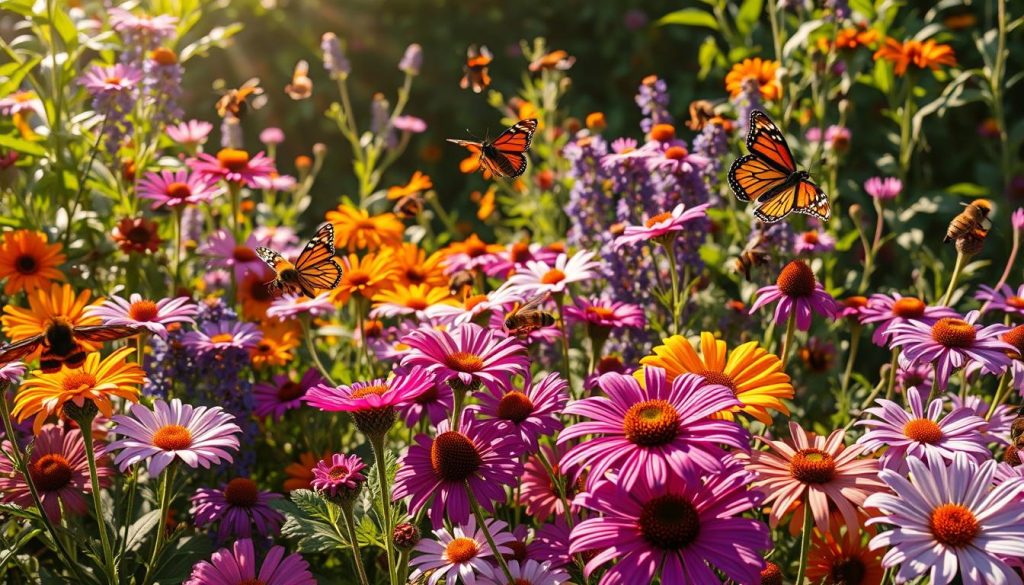
By picking the right plants, you can make a stunning garden. It will attract butterflies and help the local ecosystem. With some planning and creativity, your garden can become a haven for these beautiful creatures.
Best Shrubs to Attract Pollinators
Shrubs are great for attracting pollinators. They add beauty and structure to your garden. Plus, they offer nectar and pollen for bees and butterflies. Photinia, Butterfly Bush, and Azaleas are excellent choices.
These shrubs are easy to care for. They create a perfect haven for pollinators. By adding them to your garden, you support local pollinators and enjoy their beauty.
Photinia
Photinia is a versatile shrub. It blooms with white flowers in spring, attracting pollinators.
Butterfly Bush
Butterfly Bush is a hit with pollinators. Its long, conical flowers come in pink, purple, and white.
Azaleas
Azaleas are loved for their vibrant spring flowers. They attract bees and butterflies.
These shrubs offer many benefits. They provide nectar and pollen, are easy to care for, and add beauty to your garden.
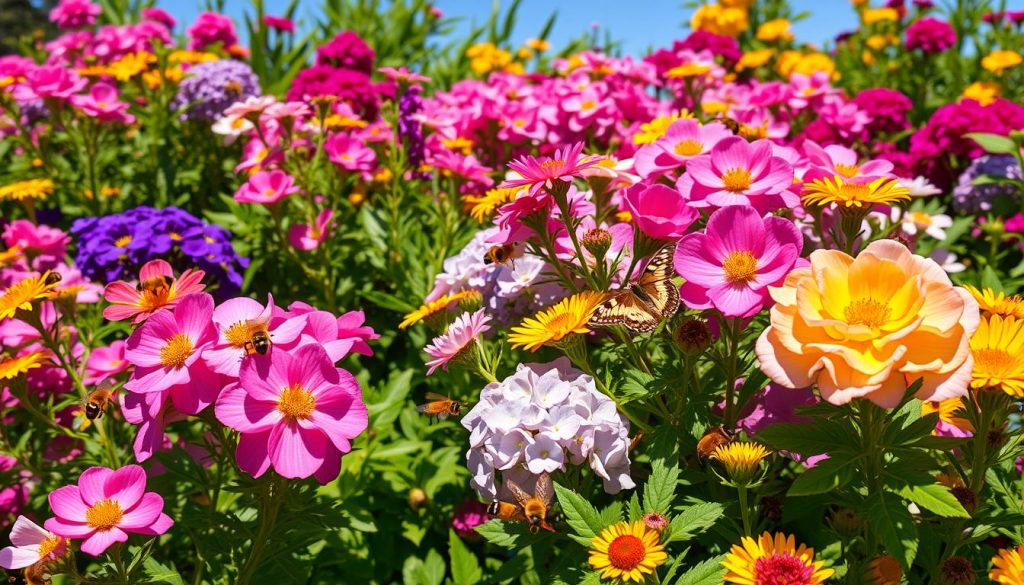
Choosing these shrubs makes your garden a haven for pollinators. It’s vital for our ecosystem’s health.
| Shrub | Flower Color | Pollinator Attraction |
|---|---|---|
| Photinia | White | Bees, butterflies |
| Butterfly Bush | Pink, purple, white | Butterflies, bees, hummingbirds |
| Azaleas | Pink, purple, white | Bees, butterflies, hummingbirds |
Herbs that Bring in the Buzz
I’m excited to share my favorite herbs that attract pollinators. These include lavender, basil, and oregano. They add flavor and fragrance to your garden while helping local pollinators.
These herbs are a great choice for a bee and butterfly garden. They offer nectar and pollen, attracting bees and butterflies. Using herbs in your garden has many benefits:
- They attract bees, butterflies, and hummingbirds.
- They add flavor and fragrance to your cooking and outdoor spaces.
- They require minimal maintenance and care.
Lavender and oregano are also great for butterfly gardens. They can grow well in different conditions. Adding these herbs to your garden creates a haven for pollinators and adds beauty and fragrance.
Looking to plant a small herb garden or add these plants to your landscape? Herbs like basil and oregano are perfect. They’re easy to care for and attract bees and butterflies, making them ideal for a pollinator-friendly garden.
The Role of Native Plants in Pollination
Exploring pollinator-friendly plants, I’ve learned how vital native plants are. They’ve evolved with local pollinators, making them key for attracting bees and butterflies. This is crucial for our gardens.
Benefits of Native Species
Native plants bring many advantages. They offer food and shelter for pollinators. By adding them to our gardens, we make a space that’s good for both beauty and the environment.
Examples of Native Plants
Here are some native plants great for pollinators:
- Wildflowers, such as black-eyed Susans and coneflowers
- Shrubs, like butterfly bush and azaleas
- Trees, including oak and willow
How to Choose Native Plants
When picking native plants, think about what pollinators in your area need. Choose plants native to your region. They should offer nectar and pollen for bees and butterflies. This helps our local ecosystem and supports environmental health.
Annuals that Support Pollinators
I’m excited to share my favorite annuals that help pollinators. These plants add color and beauty to your garden. They also attract bees and butterflies, giving them the food they need.
Some of the best plants for bees and butterflies are annuals. My top picks include:
- Zinnias, which are a favorite of butterflies and hummingbirds
- Cosmos, which are a rich source of nectar and pollen for bees and butterflies
- Marigolds, which are easy to grow and attract a variety of pollinators
These flowers are not only beautiful but also easy to care for. They can thrive in many conditions. By choosing these plants, you can make your garden stunning and help pollinators.
Adding these annuals to your garden lets you enjoy nature’s beauty. It also helps our ecosystem. So, why not try these plants and make a garden that supports pollinators for years?
Creating a Year-Round Pollinator Haven
To make a pollinator haven all year, pick plants that bees and butterflies love. Choose flowers, shrubs, and trees that bloom at different times. This way, pollinators always have nectar and pollen.
For a pollinator-friendly habitat, plant native species. Also, offer water and a cozy spot for them to rest. Here’s how to start:
Seasonal Planting Strategies
- Plant a mix of annuals and perennials for constant blooms
- Choose plants that bloom at different times for year-round nectar and pollen
- Incorporate native plants to attract native pollinators
Providing Water and Shelter
Offer water, like a shallow dish or birdbath, to support pollinators. Also, create a sheltered spot, like a brush pile or rock pile. This gives pollinators a place to rest and hide.
Tips for Maintaining a Pollinator Garden
To keep your garden healthy, it’s key to support local pollinators. Use organic gardening, manage pests safely, and care for your plants well. This way, you’ll have a lively and green space for bees and butterflies.
Organic Gardening Practices
Use natural ways to make your soil better and plants stronger. Add compost, mulch, and natural fertilizers. They give plants what they need without harming them.
Pest Management Without Chemicals
Stay away from harsh pesticides. Instead, use gentle methods to control pests. Handpick bugs, use row covers, and welcome helpful insects like ladybugs. This keeps your garden safe for pollinators.
Sourcing and Care for Plants
Get plants from trusted local nurseries or seeds. Make sure they’re free from bad chemicals. Plant them right, water them when needed, and prune carefully. With the right care, your garden will be a welcoming place for pollinators.

